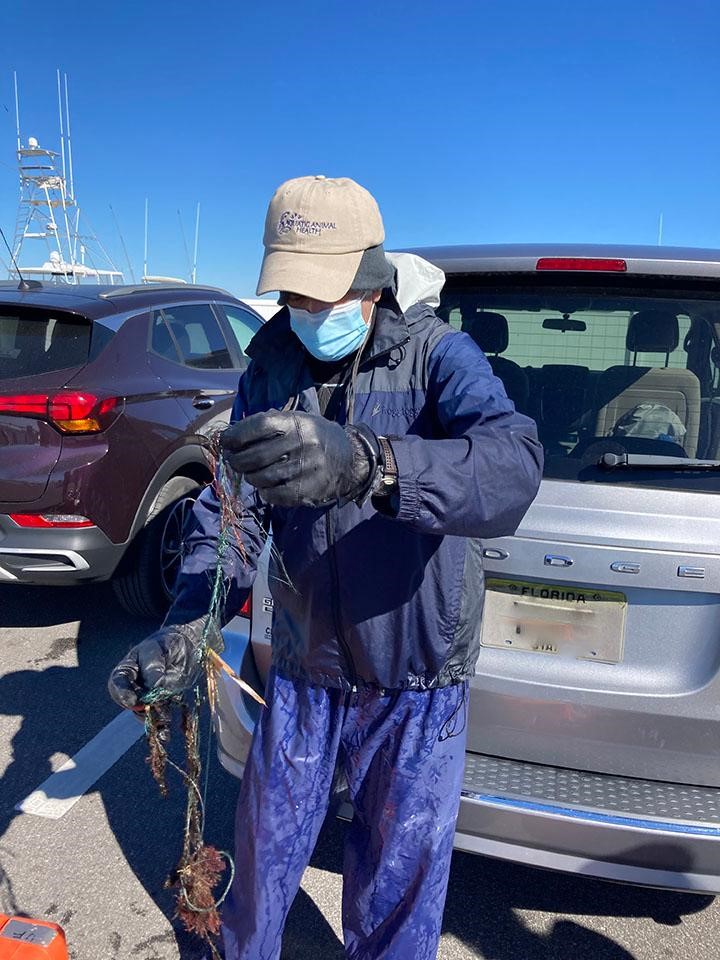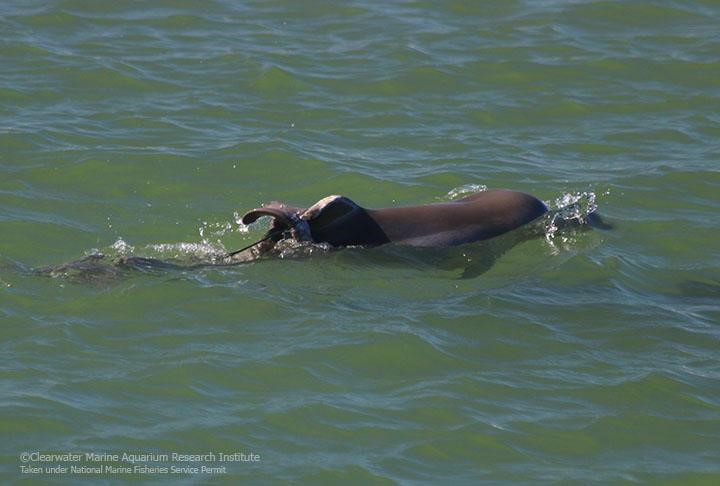Aquatic Animal Health team participates in young dolphin rescue

Dr. Mike Walsh with the line removed from the dolphin calf. The gear that nearly severed her dorsal fin included braided, multi-strand fishing line, several types of monofilament and some swivels. (Photo courtesy of SDRP)
As part of a group effort, the University of Florida Aquatic Animal Health team participated in a risky rescue involving the disentanglement of a young dolphin near Clearwater Bay on Jan. 18. Thankfully, the effort was successful, participants said.
“We were invited after an expert panel for the National Oceanic and Atmospheric Administration’s National Marine Fisheries Service determined that the entanglement was life threatening,” said Dr. Mike Walsh, a clinical associate professor at UF who works with the team and served as veterinary lead in the effort.
Randy Wells of the Sarasota Dolphin Research Program organized the event and led the catch efforts.
“While we knew that such an operation involved many risks to both the dolphin and the humans, the participants agreed that the calf faced a near-certain and very nasty death if the gear was not removed,” Wells said.
The dolphin, a 2021 calf still paired with its mother, “Matilda,” was first observed by the Clearwater Marine Aquarium entangled in the line on Dec. 4. Aquarium personnel continued to monitor the calf to see if it would shed the line on its own and also worked with the Florida Fish and Wildlife Conservation Commission to attempt to remove the line remotely using a long-handled cutting tool. But despite its compromised condition, the calf was highly mobile and managed to evade the team attempting to remove the line. CMA continued to observe the calf through December and into January and noted that the entanglement had become even more severe, with line now also wrapping around the dolphin’s peduncle — the place where the dolphin’s tail connects to its body.
On Jan. 18, the Sarasota program led the rescue attempt — an operation that included eight boats and 38 trained personnel from CMA, FWC, SeaWorld, Mote Marine Laboratory and the NMFS Southeast Regional Office, along with Walsh and Dr. Craig Pelton from UF, Dr. Marquardt from CMA, as well as staff from UF’s Marine Animal Rescue group, Suzanna Mickey, Hannah Walsh and Dr. Dana Lanier, a volunteer and drone pilot from UF.
The team converged on the Seminole boat ramp at 9 a.m., with a CMA scout team already on the water to search for Matilda and her calf. The pair was spotted north of the ramp, and the rest of the team headed out just before 10 a.m.
“The wind was blowing 10-20 knots out of the north and there were whitecaps on the water,” Wells said. “Air temperature was 40 degrees and the water temperature was in the low 60s — not one of Florida’s more pleasant days for being outdoors and wet.”
At 10:53 a.m., the group encircled the dolphins and had both mom and calf restrained in the water by 10:55 a.m.
“As lead veterinarian Mike Walsh and his veterinary team were quickly removing the line from the calf, the very feisty mom broke away from her handlers but remained near her calf,” Wells said. “He finished removing the line and gave the calf — which was determined to be a female — a dose of antibiotics. At 10:58 a.m., both dolphins were released and swam off together.”
The dorsal fin was badly damaged, and care was taken to avoid further injury. Pelton monitored the calf’s reactions to handling, including heart rate, respiration and behavior for signs of problems. Walsh noted afterward that while the calf was thin, it was in better condition than expected from photos. It was also strong and showed a lot of normal behavior, so the group is hopeful the dolphin will survive.
Clearwater team members spotted Matilda and her calf a few days after the intervention and reported that the calf was more active and swimming much better than before the line was removed.
“It was a young animal with potential concerns with survival, and thankfully the disentanglement occurred very quickly, due to the extensive experience of the many team members involved with the capture, who assisted in the removal and who held the calf while we worked on it,” Walsh said.













